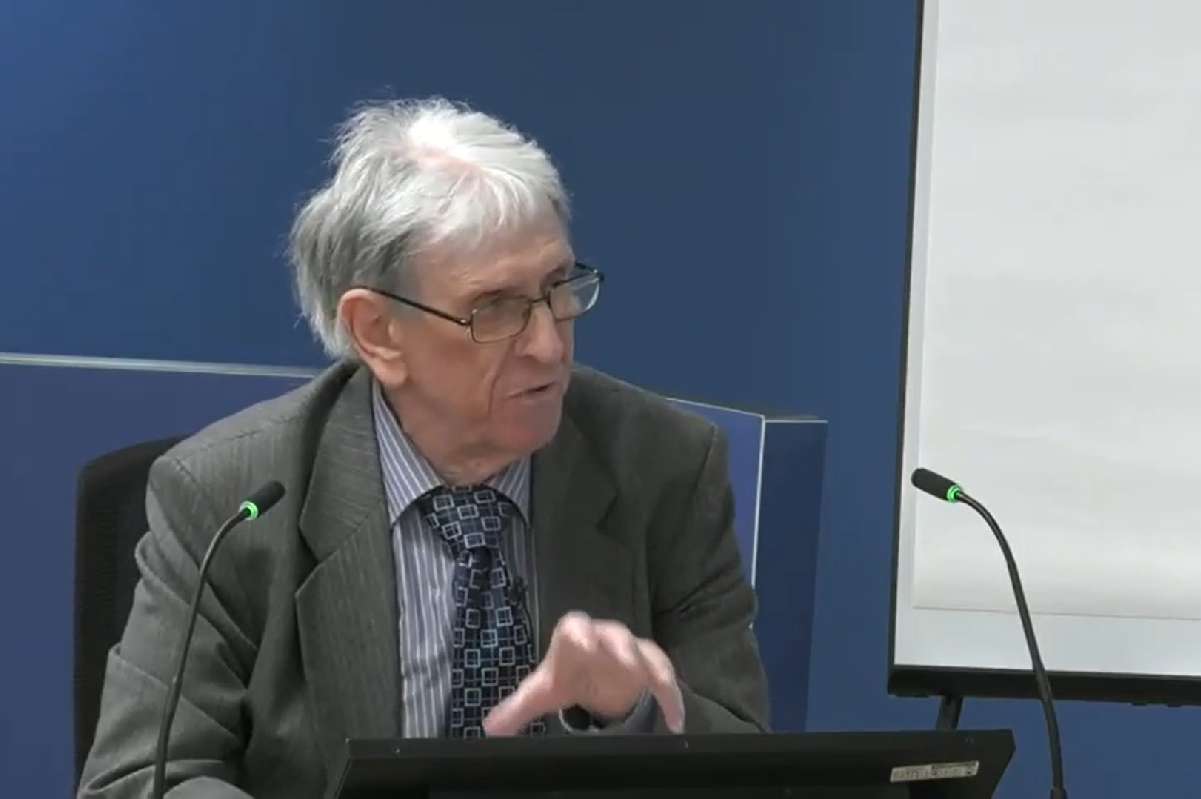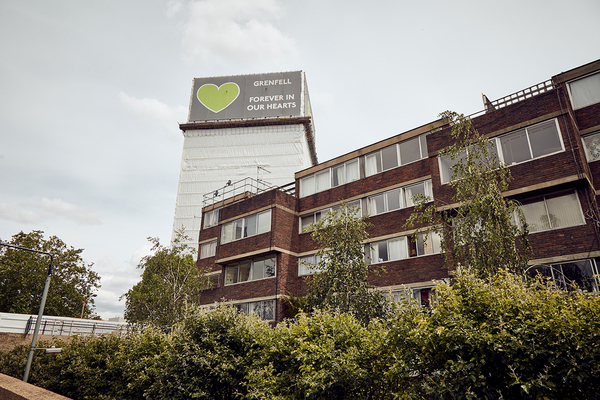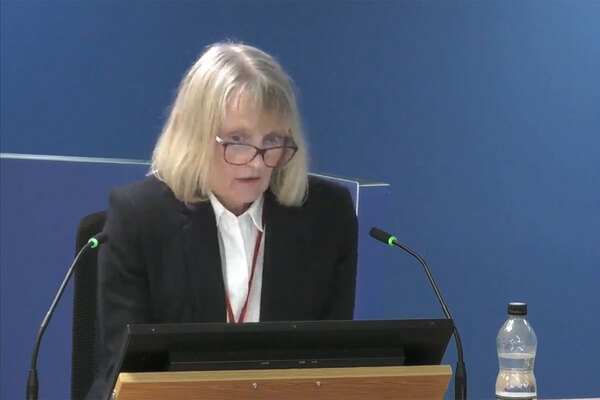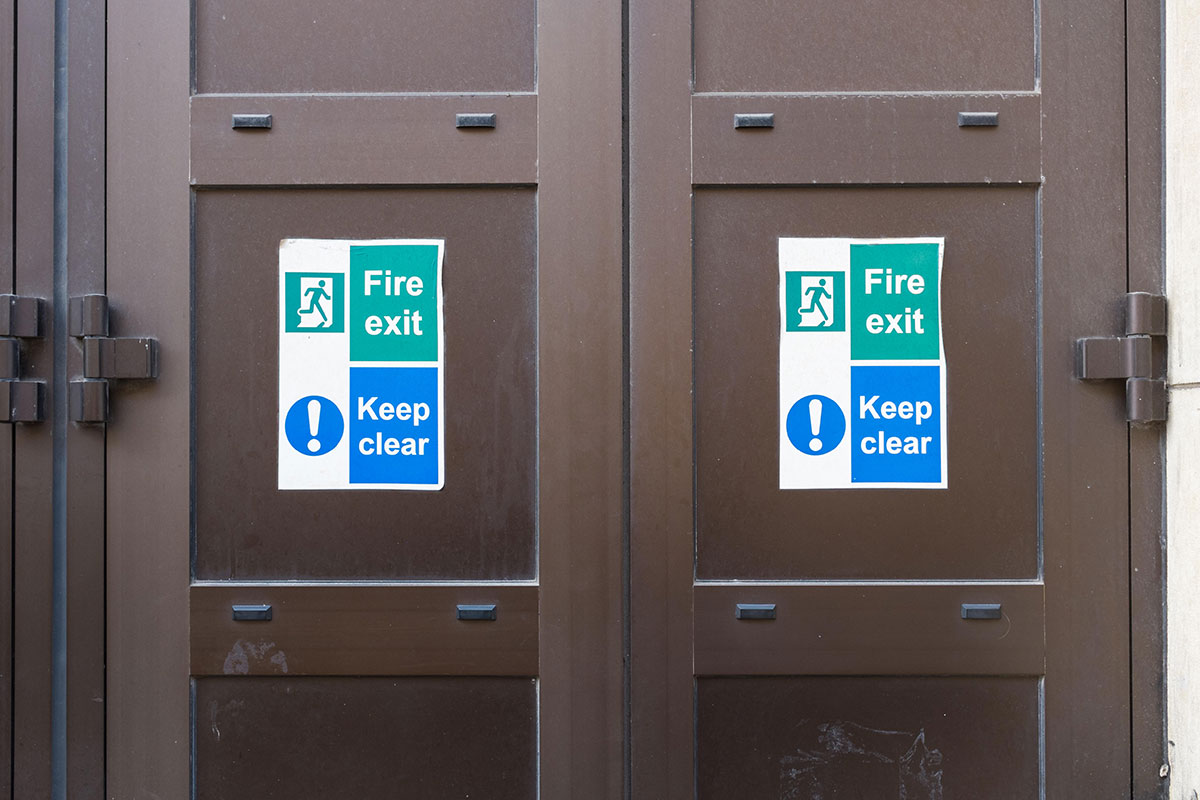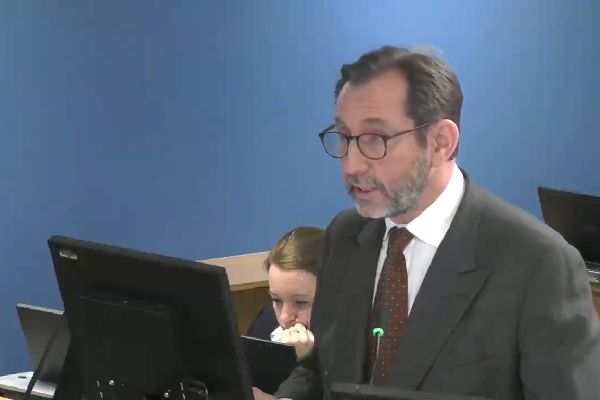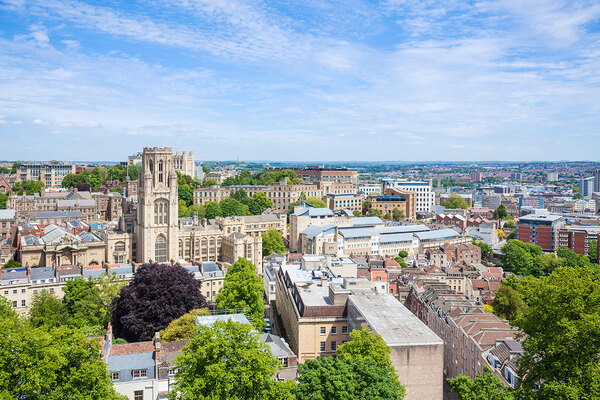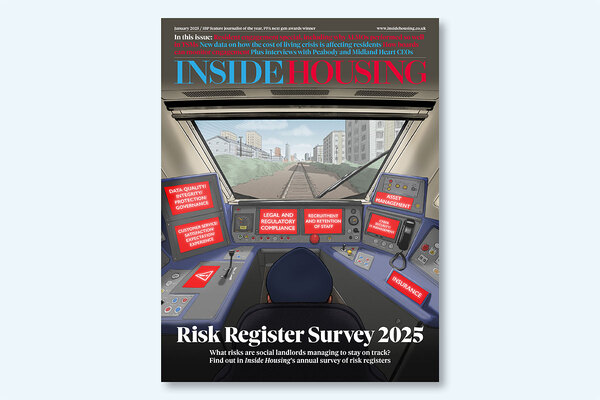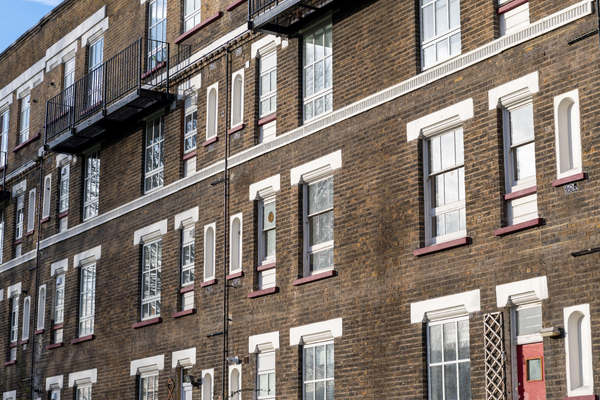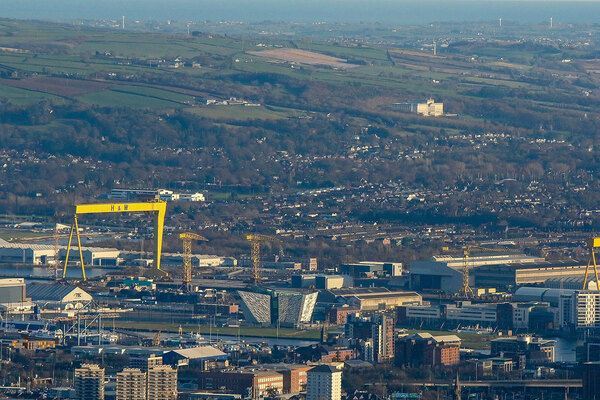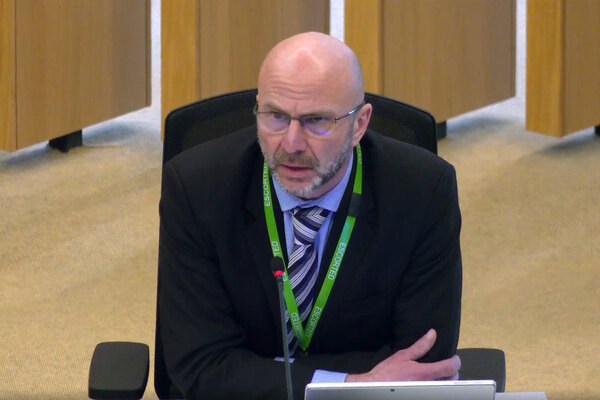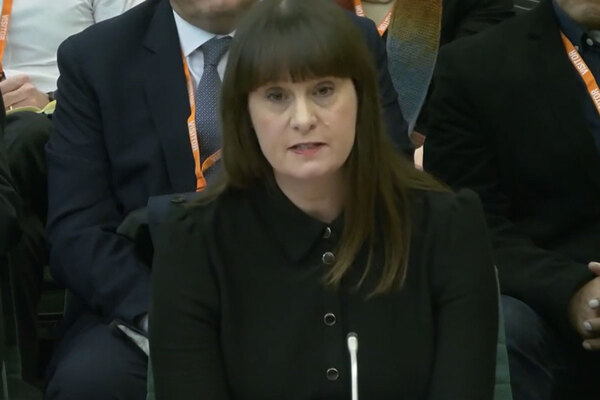Rapid spread of smoke to lobbies a ‘key event’ in Grenfell deaths, expert witness says
The “rapid” filling of lobbies outside flats with smoke, often due to missing self-closers on front doors, was a “key event” in the deaths at Grenfell Tower, an expert toxicologist has told the inquiry.
The inquiry heard yesterday from Professor David Purser, a toxicology expert, who has analysed the production of toxic smoke during the fire and its impact on the tower’s residents.
Richard Millett QC, counsel to the inquiry, issued a trigger warning at the start of the day’s evidence noting that it would include “descriptions of facts and matters about the deceased’s last movements and the immediate causes of death, which many will find distressing”.
Professor Purser outlined what he described as the ‘phases’ of the Grenfell Tower fire – explaining that fire initially ripped upwards in a straight column, breaking into the kitchens of the flats with a door number ending in six on each floor.
This resulted in a rapid evacuation of these flats in the very early stages of the fire.
“They [residents of these flats] rushed very quickly, some of them ran out only partially dressed, they went to maybe grab a phone and a passport and the children and all the occupants of flats 6 evacuated the flats within very few minutes, very, very quickly,” he said.
While some of them went upwards to the top floor where they later died, most left the building without difficulty with the lobbies and the stairwell generally clear and inhaled only minimal levels of smoke.
However, after this point, the lobby areas “became filled with dense smoke” within “a few minutes”.
“I feel [this] strongly inhibited those who had remained in their flats from attempting to escape,” said Professor Purser. “[It] led to many of them remaining in their flats and ultimately led to them being overcome by asphyxiant gases and dying in their flats. So this was a key event.”
The inquiry has previously heard evidence that ‘self-closing’ devices on dozens of flat entrances doors in the tower were missing or broken, despite specific warnings to the Royal Borough of Kensington and Chelsea from the London Fire Brigade (LFB) to fix this issue across their housing stock after a previous fire revealed the same issue at another block.
But they did not, with an internal document noting the “huge costs” of a fire door inspection programme.
Grenfell Tower itself had been served with a deficiency notice in November 2016 by the London Fire Brigade which said: “The protected route [the staircase and the lobbies] has been compromised by the fitting of doors that do not self-close.”
The deadline to fix this issue was 18 May 2017 – a month before the fire. But post-fire investigations showed 43 front doors in the tower had no self-closers installed and 34 were not working – two-thirds of all the tower’s doors.
“If the flat door was left open and if it remained open, then there was a clear path for smoke to flow out,” said Professor Purser. “Of course, these [doors] were designed to have self-closers on them… but there seems to have been a problem with this.”
He said on floors where doors were open, “the flow of smoke and filling of the lobby was rapid”. However, on floors where doors were believed to have been closed, there was a “considerable delay”. On the 18th floor, for example, “there was a good 20 minutes or so before the lobby became filled with smoke”.
Professor Purser said some residents were able to escape through the lobby, enter the stairs and escape the building, but many chose not to because their flats were smoke free and the conditions on the landing were severe.
They were also being advised to stay put by the London Fire Brigade and promised rescue by firefighters.
“Not only did they have the immediate problem of the horrible conditions they were facing in the lobby, but they also had the question of: if I were to make it through this lobby to the stair, what’s it going to be like,” he said – adding that those with disabilities, children or pregnant women were particularly unlikely to risk the conditions outside their front doors.
Then, as the fire moved laterally around the building, more flats were progressively affected by the flames. “Now they [residents still inside the tower] had a very urgent situation, because they had a large fire coming round the outside and penetrating from the outside of their flats, and they also had the dense smoke in the lobbies,” he explained.
He said the lobbies were “extremely hazardous” at this point, but if residents fled before the fire entered their flats, many were able to hold their breath, cross the lobby and escape via the stairs.
“This shows that the conditions in the stairs remained survivable, if you like, negotiable, for a long period of time during the incident, and if people were encouraged to leave before they were overcome in their flats, they had a good chance of being able to make it out alive,” he said.
He said that by the time the lobbies reached pitch darkness with smoke, they were so full of carbon monoxide and cyanide that they would cause collapse within three to four minutes.
But this was even worse for those who had already built up large quantities of asphyxiant gas in their blood due to breathing in smoke in their flats – meaning they collapsed almost as soon as they entered the lobby or the stairs.
“Some people were trapped in their flats for up to two hours, and during that period they nearly all… reported smoke leakage around their front doors, flat entrance doors, into their flats from the lobby. So this very bad lobby smoke is leaking into the flats,” he said.
Some were able to limit this exposure by opening windows on sides of the building which were not on fire, or by moving from room to room and closing doors.
He said that while the conditions in the stairs became more serious as the night progressed, they were never as bad as the lobbies and were survivable for around 15 to 30 minutes for adults – although this reduced sharply if they had already inhaled large quantities of smoke.
Professor Purser explained that smoke creates tipping points as the concentration of carbon in the blood increases – with 30% the threshold for collapse and 50% for death, although the former is higher if people are sitting still.
He said collapse due to smoke was sudden, “a sort of physiological cliff”, and added that his studies of levels of toxins in the bodies of victims left him “convinced that [victims] died from smoke exposure… not from burns”.
A major theme of the inquiry has been the impact on disabled residents – who were disproportionately represented among the victims of the fire.
“If an occupant was impaired by a health condition from coming down the stairs at all or impaired from descending within the window of time before accumulating that incapacitating dose, would it follow that their prospects of escape were negated or reduced?” asked Mr Millett.
“Yes,” replied Professor Purser. He caveated his answer by noting that in severe smoke conditions, able-bodied people may travel as slowly as people with certain disabilities.
However, he said: “Of course, [if] you’re unable to come down at all, then obviously you’re forced to remain in your flat.”
The government has recently proposed rejecting a recommendation of the first phase of the inquiry that disabled residents be offered ‘personal emergency evacuation plans’ to give them a better chance of escaping a fire.
Professor Purser said there were three main contributors to the smoke in the tower: the cladding system on the external walls, the window surrounds and the contents of the individual flats.
He said that while the violently combustible polyethylene in the cladding panels produced mainly carbon monoxide, the insulation – mostly produced by Celotex – contained nitrogen and therefore also produced hydrogen cyanide, which would also have been produced by burning upholstered furniture in the flats.
Asked about the contribution of cyanide to the deaths at Grenfell, he said it was “relatively minor” – given that carbon monoxide was present in much higher concentrations.
However, he explained that inhaling cyanide during a fire can be “a more significant actor in collapse”, as it causes people to collapse faster than carbon monoxide. It also causes people to involuntarily increase their rate of breathing, meaning they take in more smoke.
“The main seriousness of inhaled cyanide in fires is in this rapid knockdown, rapid collapse, which then leaves you in the situation where you continue to inhale all these gases and then die,” he said.
Professor Purser carried out tests on some blood samples of victims to attempt to establish the contribution of cyanide – but these were done two years after the blaze and there is a natural “quite marked” decrease in cyanide in blood samples over time.
He explained that the results did not allow him to draw firm conclusions, but appeared to “corroborate the fact that they were exposed to some extent”, but that the exposure was “not that extreme”.
UK regulations do not generally have any standards for the production or toxicity of smoke produced by building products, with the exception of the requirement that cladding products above 18m have an ’A2’ rating for fire. This was introduced after the Grenfell Tower fire.
Professor Purser is an internationally respected toxicologist and has appeared as an expert witness at proceedings worldwide, including the Mont Blanc tunnel fire which killed 39 people in 1999.
The inquiry continues with further evidence from Professor Purser today.
Update at 2.30pm on 30.6.22:
A paragraph on UK regulations was updated to clarify that the A2 rating for fire performance for cladding products above 18m includes standards relating to smoke production
Sign up for our weekly Grenfell Inquiry newsletter
Each week we send out a newsletter rounding up the key news from the Grenfell Inquiry, along with the headlines from the week
Already have an account? Click here to manage your newsletters
